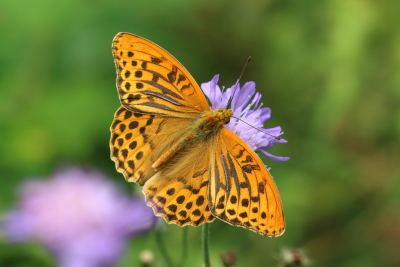














Silver-washed Fritillary (Argynnis paphia)
2024 photographs highlighted in yellow. Click on any photograph to go to an enlarged picture, or simply scroll down the page.
|
A common species almost everywhere. Five of the photographs show the form valezina, a variant of the female where both surfaces have a bronze-green suffusion, giving it a superficial similarity to the Cardinal (A. pandora). I have only seen one valezina in England, where it is comparatively infrequent, but in Var, valezina consistently makes up around 30% of the female paphia population, and this has been consistent every year. |
Valezina is sometimes spelt valesina.
The male paphia has very pronounced sex brands, giving it a more "streaky" appearance, whereas the female seems more "spotted". |
| ref | sex |
observations |
alt. m |
| 18256 | M |
a male, fresh and quite heavily marked. |
1120 |
| 2355 | M |
a typical male with very heavy sex brands on veins 1-3 and a smaller one on s4. |
450 |
| 52925 | M | a male, with fully open wings and quite still in a spell of overcast weather. | 920 |
| 16342 | F |
a female of the nominate form, quite heavily marked. |
220 |
| 49354 | F | a pristine female, which appeared to have just emerged, given that it rested with open wings for a while. There is a slight bluish tinge at the forewing margin which may be a function of the camera angle or possibly a feature of its fresh emergence. 49357 is the underside. | 200 |
| 49735 | F | a female of the form valezina, quite dull and dusky even though it appeared fresh from the intact state of the fringes. | 1380 |
| 16322 | F |
a female of the form valezina, very heavily marked and appearing almost black in flight. |
220 |
| 16498 | F |
a female of the form valezina taking moisture from a damp mud puddle. |
450 |
| 2661 | F |
a female upperside of the form valezina. |
450 |
| 43040 | M | a male taking salts from the top of a wall made of some type of brick. The surface appeared completely dry, so how this male was actually extracting anything is rather a mystery. | 430 |
| 18246 | M |
a male, nice developed silvery-white unh streaks. |
1120 |
| 18401 | M |
a male, very limited silvery-white streaks on the unh - contrast with 18246 from the same location and time. |
1120 |
| 49357 | F | a female, the underside of 49354, with strong and complete silver streaks in the discal and marginal regions. | 200 |
| 40761 | F | a female with a particularly green underside. | 840 |
| 11591 | F |
T&L says there is a form argyrea which has no silver streaks on the unh and occurs in northern Italy and Spain, and 11591 matches the illustration of this in T&L quite closely. H&R refers to this form as anargyria. I am inclined to assume that it is an underside of the form valezina, but T&L does not give an illustration of this so I cannot be 100% certain, although I cannot see what else it could be, on the assumption that H&R is correct regarding the distribution of anargyria. If it is valezina, it has to be a female. |
220 |
49735_female_Hautes-Alpes_9Jul22
16322_female_Var_20Jun09 - form valezina
16498_female_Var_23Jun09 - form valezina
2661_female_Var_11Jul06 - form valezina
11591_female_Var_27Jun08 - form valezina